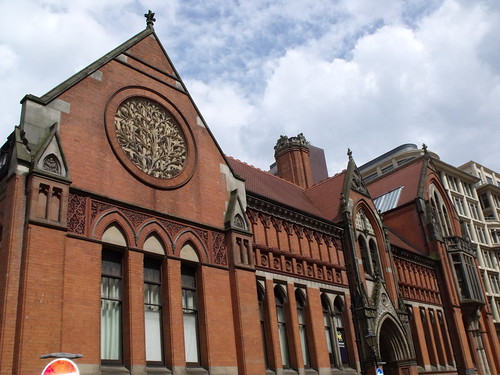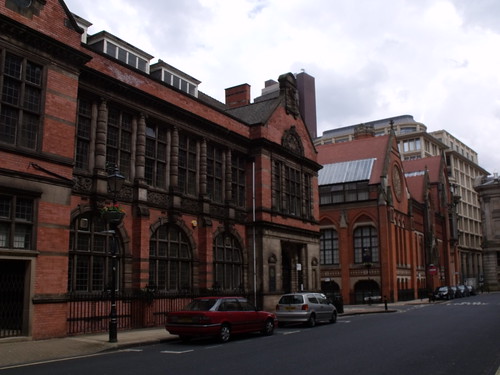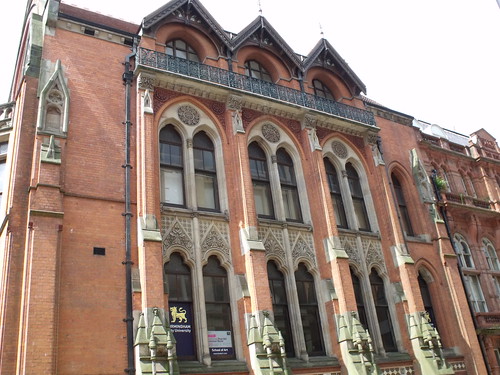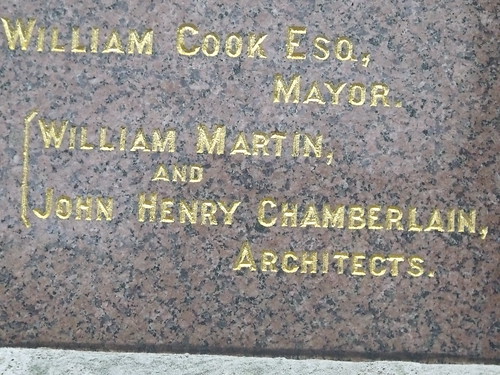Birmingham School of Art
Image by ell brown
The School of Art opposite BM&AG. This used to be The College of Art, part of the old Birmingham Polytechnic, which later became the UCE and now BCU.
The Birmingham School of Art was a municipal school based in the centre of Birmingham. Although the organisation was absorbed into the Birmingham Polytechnic in 1971, it is now part of Birmingham City University's Birmingham Institute of Art and Design, it is Grade I listed.
The building is on Margaret Street, and it remains part of the university's Department of Fine Art, but it is still commonly referred to its original title.
The building is a red Victorian Gothic structure, completed after the death of architect J. H. Chamberlain, by his partner William Martin and his son Frederick Martin. Foundation stone laid in 1884, completed a year later in 1885.
An extension was built in 1892-93 by Martin & Chamberlain running east down Cornwall Street. It was renovated and refurbished between 1992 and 1996 by Associated Architects.
When it was listed in 1970 it was listed as the Art And Design Annexe, Birmingham Polytechnic. Obviously now it is the Birmingham City University School of Art.
1881-85, by Martin and Chamberlain and extended along Cornwall Street in 1893. Brick and terracotta with stone dressings and some tile decoration and with mosaic in the central gable; tiled roof with bracketted eaves cornice and decorative ridge tiles. In a Gothic style. Three and 4 storeys; 5 bays, the central and outer ones all gabled though differently in width and height, a facade as brilliantly successful as it is wholly asymmetrical. The centre bay with the gabled entrance arch flanked by pinnacles and carrying a big pointed arched opening within the gable above. The door behind gates and up a steep flight of steps within a room with arches carried on granite columns and a flat panelled wooden ceiling. Ground floor windows all with shouldered and moulded heads. First floor windows all broad lancets in various groupings; then, on the left a roundel by Barlow of Leicester with splended foliage in an Art Nouveau style, a band of trefoil headed lancets with roundels below and, on the right, a big canted bay window carried on a tripartite buttress rising up from basement level and with a triplet of lancets above. Excellent floral details in the spandrels. Inside, too, with excellent detailing everywhere including mosaic floors, stained glass windows, fine metalwork and joinery and carved capitals. The studios on the top floor large and functionally constructed with big iron arches with quatrefoils. On the return, the 9 bays of the extension differ from the 5 bays of the original in having figures (by Benjamin Creswick) rather than foliage in the tympana of the arches.
Birmingham School of Art - Heritage Gateway
Birmingham School of Art
Image by ell brown
The School of Art opposite BM&AG. This used to be The College of Art, part of the old Birmingham Polytechnic, which later became the UCE and now BCU.
The Birmingham School of Art was a municipal school based in the centre of Birmingham. Although the organisation was absorbed into the Birmingham Polytechnic in 1971, it is now part of Birmingham City University's Birmingham Institute of Art and Design, it is Grade I listed.
The building is on Margaret Street, and it remains part of the university's Department of Fine Art, but it is still commonly referred to its original title.
The building is a red Victorian Gothic structure, completed after the death of architect J. H. Chamberlain, by his partner William Martin and his son Frederick Martin. Foundation stone laid in 1884, completed a year later in 1885.
An extension was built in 1892-93 by Martin & Chamberlain running east down Cornwall Street. It was renovated and refurbished between 1992 and 1996 by Associated Architects.
When it was listed in 1970 it was listed as the Art And Design Annexe, Birmingham Polytechnic. Obviously now it is the Birmingham City University School of Art.
1881-85, by Martin and Chamberlain and extended along Cornwall Street in 1893. Brick and terracotta with stone dressings and some tile decoration and with mosaic in the central gable; tiled roof with bracketted eaves cornice and decorative ridge tiles. In a Gothic style. Three and 4 storeys; 5 bays, the central and outer ones all gabled though differently in width and height, a facade as brilliantly successful as it is wholly asymmetrical. The centre bay with the gabled entrance arch flanked by pinnacles and carrying a big pointed arched opening within the gable above. The door behind gates and up a steep flight of steps within a room with arches carried on granite columns and a flat panelled wooden ceiling. Ground floor windows all with shouldered and moulded heads. First floor windows all broad lancets in various groupings; then, on the left a roundel by Barlow of Leicester with splended foliage in an Art Nouveau style, a band of trefoil headed lancets with roundels below and, on the right, a big canted bay window carried on a tripartite buttress rising up from basement level and with a triplet of lancets above. Excellent floral details in the spandrels. Inside, too, with excellent detailing everywhere including mosaic floors, stained glass windows, fine metalwork and joinery and carved capitals. The studios on the top floor large and functionally constructed with big iron arches with quatrefoils. On the return, the 9 bays of the extension differ from the 5 bays of the original in having figures (by Benjamin Creswick) rather than foliage in the tympana of the arches.
Birmingham School of Art - Heritage Gateway
Birmingham and Midland Institute and Birmingham School of Art
Image by ell brown
The Birmingham and Midland Institute is now on Margaret Street, in Birmingham City Centre. It was a pioneer of adult scientific and technical institution (General Industrial, Commercial and Music) and it today offers Arts and Sciences lectures.
When the old mid 19th century building was demolished in 1965 as part of the redevelopment of Birmingham City Centre, the BMI moved to Margaret Street, the home of the private Birmingham Library, which is a Grade II* listed building, designed in 1889 by architects Jethro Cossins, F. B. Peacock, and Ernest Bewly.
-----------------------------------------------------------------------------
The Birmingham School of Art was a municipal school based in the centre of Birmingham. Although the organisation was absorbed into the Birmingham Polytechnic in 1971, it is now part of Birmingham City University's Birmingham Institute of Art and Design, it is Grade I listed.
The building is on Margaret Street, and it remains part of the university's Department of Fine Art, but it is still commonly referred to its original title.
The building is a red Victorian Gothic structure, completed after the death of architect J. H. Chamberlain, by his partner William Martin and his son Frederick Martin. Foundation stone laid in 1884, completed a year later in 1885.
An extension was built in 1892-93 by Martin & Chamberlain running east down Cornwall Street. It was renovated and refurbished between 1992 and 1996 by Associated Architects.
When it was listed in 1970 it was listed as the Art And Design Annexe, Birmingham Polytechnic. Obviously now it is the Birmingham City University School of Art.
1881-85, by Martin and Chamberlain and extended along Cornwall Street in 1893. Brick and terracotta with stone dressings and some tile decoration and with mosaic in the central gable; tiled roof with bracketted eaves cornice and decorative ridge tiles. In a Gothic style. Three and 4 storeys; 5 bays, the central and outer ones all gabled though differently in width and height, a facade as brilliantly successful as it is wholly asymmetrical. The centre bay with the gabled entrance arch flanked by pinnacles and carrying a big pointed arched opening within the gable above. The door behind gates and up a steep flight of steps within a room with arches carried on granite columns and a flat panelled wooden ceiling. Ground floor windows all with shouldered and moulded heads. First floor windows all broad lancets in various groupings; then, on the left a roundel by Barlow of Leicester with splended foliage in an Art Nouveau style, a band of trefoil headed lancets with roundels below and, on the right, a big canted bay window carried on a tripartite buttress rising up from basement level and with a triplet of lancets above. Excellent floral details in the spandrels. Inside, too, with excellent detailing everywhere including mosaic floors, stained glass windows, fine metalwork and joinery and carved capitals. The studios on the top floor large and functionally constructed with big iron arches with quatrefoils. On the return, the 9 bays of the extension differ from the 5 bays of the original in having figures (by Benjamin Creswick) rather than foliage in the tympana of the arches.
Birmingham School of Art - Heritage Gateway
Before public libraries were provided there were private and subsciption libraries, of which there were several in Birmingham. The most important one, which subsequently became the Birmingham Library, was established in 1779. From 1797 until 1899 this library was in its own premises in Union Street, designed by William Hollins. It then moved to a new building, designed by Cossins & Peacock, on the corner of Margaret Street and Cornwall Street, now owned by the Birmingham and Midland Institute, and Grade II listed.
From Victorian Buildings of Birmingham by Roy Thornton
Birmingham School of Art - Edmund Street facade
Image by ell brown
School of Art - Edmund Street facade.
The School of Art opposite BM&AG. This used to be The College of Art, part of the old Birmingham Polytechnic, which later became the UCE and now BCU.
The Birmingham School of Art was a municipal school based in the centre of Birmingham. Although the organisation was absorbed into the Birmingham Polytechnic in 1971, it is now part of Birmingham City University's Birmingham Institute of Art and Design, it is Grade I listed.
The building is on Margaret Street, and it remains part of the university's Department of Fine Art, but it is still commonly referred to its original title.
The building is a red Victorian Gothic structure, completed after the death of architect J. H. Chamberlain, by his partner William Martin and his son Frederick Martin. Foundation stone laid in 1884, completed a year later in 1885.
An extension was built in 1892-93 by Martin & Chamberlain running east down Cornwall Street. It was renovated and refurbished between 1992 and 1996 by Associated Architects.
When it was listed in 1970 it was listed as the Art And Design Annexe, Birmingham Polytechnic. Obviously now it is the Birmingham City University School of Art.
1881-85, by Martin and Chamberlain and extended along Cornwall Street in 1893. Brick and terracotta with stone dressings and some tile decoration and with mosaic in the central gable; tiled roof with bracketted eaves cornice and decorative ridge tiles. In a Gothic style. Three and 4 storeys; 5 bays, the central and outer ones all gabled though differently in width and height, a facade as brilliantly successful as it is wholly asymmetrical. The centre bay with the gabled entrance arch flanked by pinnacles and carrying a big pointed arched opening within the gable above. The door behind gates and up a steep flight of steps within a room with arches carried on granite columns and a flat panelled wooden ceiling. Ground floor windows all with shouldered and moulded heads. First floor windows all broad lancets in various groupings; then, on the left a roundel by Barlow of Leicester with splended foliage in an Art Nouveau style, a band of trefoil headed lancets with roundels below and, on the right, a big canted bay window carried on a tripartite buttress rising up from basement level and with a triplet of lancets above. Excellent floral details in the spandrels. Inside, too, with excellent detailing everywhere including mosaic floors, stained glass windows, fine metalwork and joinery and carved capitals. The studios on the top floor large and functionally constructed with big iron arches with quatrefoils. On the return, the 9 bays of the extension differ from the 5 bays of the original in having figures (by Benjamin Creswick) rather than foliage in the tympana of the arches.
Birmingham School of Art - Heritage Gateway
Birmingham School of Art - Memorial Stone - zoom in of William Martin and John Henry Chamberlain
Image by ell brown
I was walking past it again after taking a detor from Chamberlain Square.
From the corner of Margaret Street and Edmund Street.
I was about to go down Eden Place.
The School of Art opposite BM&AG. This used to be The College of Art, part of the old Birmingham Polytechnic, which later became the UCE and now BCU.
The Birmingham School of Art was a municipal school based in the centre of Birmingham. Although the organisation was absorbed into the Birmingham Polytechnic in 1971, it is now part of Birmingham City University's Birmingham Institute of Art and Design, it is Grade I listed.
The building is on Margaret Street, and it remains part of the university's Department of Fine Art, but it is still commonly referred to its original title.
The building is a red Victorian Gothic structure, completed after the death of architect J. H. Chamberlain, by his partner William Martin and his son Frederick Martin. Foundation stone laid in 1884, completed a year later in 1885.
An extension was built in 1892-93 by Martin & Chamberlain running east down Cornwall Street. It was renovated and refurbished between 1992 and 1996 by Associated Architects.
A memorial stone on the School of Art building. With the names William Martin and John Henry Chamberlain (the architects).
It was placed by Richard Tangye in 1884. The mayor at the time was William Cook.
A close up look at the names of this pair of famous late Victorian Birmingham architects Martin & Chamberlain.
When it was listed in 1970 it was listed as the Art And Design Annexe, Birmingham Polytechnic. Obviously now it is the Birmingham City University School of Art.
1881-85, by Martin and Chamberlain and extended along Cornwall Street in 1893.
Brick and terracotta with stone dressings and some tile decoration and with
mosaic in the central gable; tiled roof with bracketted eaves cornice and
decorative ridge tiles. In a Gothic style. Three and 4 storeys; 5 bays,
the central and outer ones all gabled though differently in width and height,
a facade as brilliantly successful as it is wholly asymmetrical. The centre
bay with the gabled entrance arch flanked by pinnacles and carrying a big
pointed arched opening within the gable above. The door behind gates and
up a steep flight of steps within a room with arches carried on granite columns
and a flat panelled wooden ceiling. Ground floor windows all with shouldered
and moulded heads. First floor windows all broad lancets in various groupings;
then, on the left a roundel by Barlow of Leicester with splended foliage in
an Art Nouveau style, a band of trefoil headed lancets with roundels below
and, on the right, a big canted bay window carried on a tripartite buttress
rising up from basement level and with a triplet of lancets above. Excellent
floral details in the spandrels. Inside, too, with excellent detailing everywhere
including mosaic floors, stained glass windows, fine metalwork and joinery
and carved capitals. The studios on the top floor large and functionally
constructed with big iron arches with quatrefoils. On the return, the 9 bays
of the extension differ from the 5 bays of the original in having figures
(by Benjamin Creswick) rather than foliage in the tympana of the arches.
Birmingham School of Art - Heritage Gateway
No comments:
Post a Comment